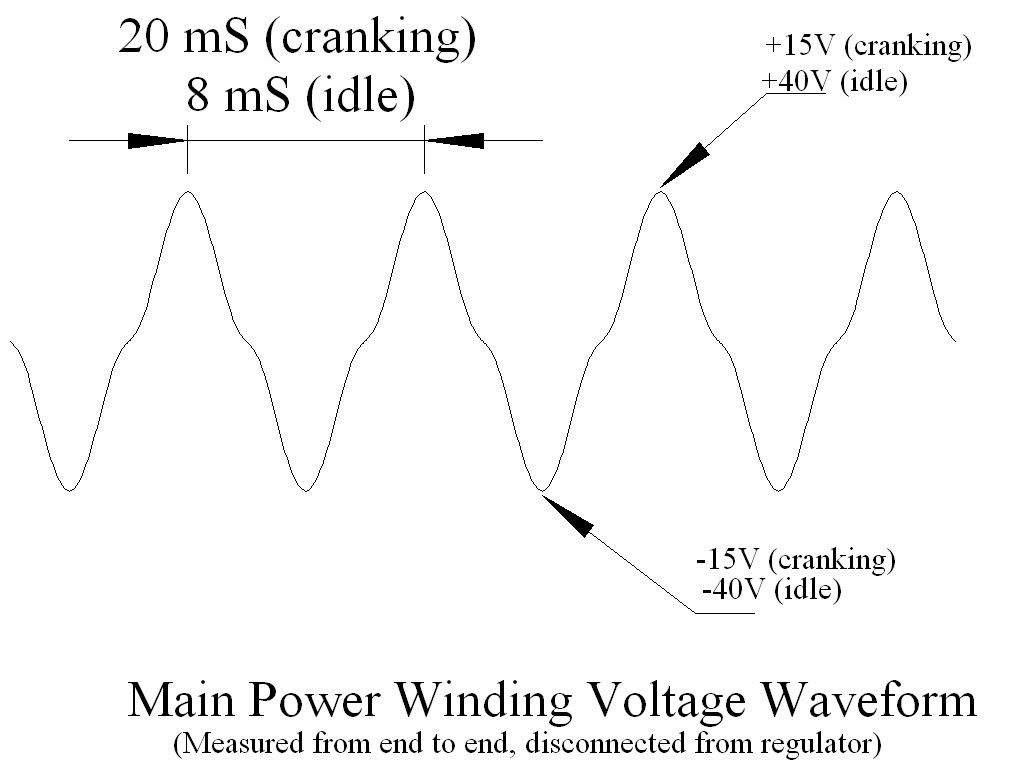|
|
#1 |
|
Join Date: Aug 2008
Location: Tracy, California
Posts: 83
|
Quad Charging Voltage Waveforms
In another thread I promised to post these. I used an oscilloscope to measure the voltage waveforms coming out of the charge winding of the stator both when disconnected and connected to the regulator. The point I'm trying to make is that the stator and regulator affect each other greatly when connected, so when there are problems it is hard to determine who is at fault. If you disconnect them you can measure the stator output voltage independantly and isolate it from the regulator.
The victim quad used for these measurements is a hensim 150cc GY6 engine with an eight pole stator. Not that that matters much for most quads, all engines have to do the same thing - i.e. put out enough charging current to run the accessories and keep the battery charged up. Some of the bigger engine quads have three phase charge windings on the stator - those are different. This post doesn't apply to them. Even though I'm measuring the voltages using an oscilloscope you don't need to do this when troubleshooting. A voltmeter is fine. But sometimes it helps to see what the voltages are really doing so that you can interpret what you are seeing on the voltmeter. The first waveform is the voltage coming out of the stator charge winding when disconnected from the regulator. When disconnected from the regulator teh stator winding is just a coil of wire with no connection to ground, so you have to measure it from end to end (wire to wire) instead of wire to ground:  Notice the huge difference in voltages between cranking and idle speeds. My quad cranks at 600 RPM and idles at around 1500 RPM. The output voltage of an unloaded stator is proportional to engine speed. The picture denotes the peak voltages, but if you measured this with a volt meter it would attempt to display RMS voltages at about 9.5 volts or 26 volts AC. The next picture shows what happens if you measure the same two wires end to end when hooked up to the regulator I get this waveform:  Notice how drastically the same measurement point has changed. The regulator has loaded down the stator to the point that is going into current limit. Here's the problem - if the regulator working normally can (and does) pull down the stator voltage, then if it is bad it could it pull down the stator voltage even more. Or maybe the stator is weak. How can you tell? You can't. If you measure the stator charge voltage while disconnected then you are measuring just the stator charge winding, and not some complex interactive system. Remember that the stator charge winding is just a coil of wire. What can go wrong? The winding could be open (use an ohmmeter and measure from winding end to end). It could be shorted to engine ground. (use ohmmeter again). It could have internal shorts between turns. You can't find this with an ohmmeter, but shorted turns will *greatly* reduce the measured AC output voltage. And since you're disconnected from the regulator then this stator problem is now isolated. The next picture shows the voltage on each end of the charge winding compared to engine ground when hooked up to the regulator. Note: Any measurment from the stator charge winding to ground when disconnected from the regualtor is meaningless since ground is connected only when the regulator is hooked up, and the connection is made at an internal point (not any of the two winding leads).  I don't want anybody to get the impression that I'm an expert at quad electrical systems. One year ago I knew nothing about quads. Then I bought one. I came with almost no documentation, and shortly thereafter quit running due to electrical problems. This is what got me started. I do know a little about electronics, but I'm sure there are others who know more. The idea here is to share information. The bad info will fade away over time and the useful info will spread. If anyone differs with what I have written your comments are welcome. I don't take offense at differing opinions. I also realize that this post is not for everyone. So feel free to ignore it as well. I have a lot of ignition waveform data also... Lynn Edwards |

|
|
|

|
 |
|
|